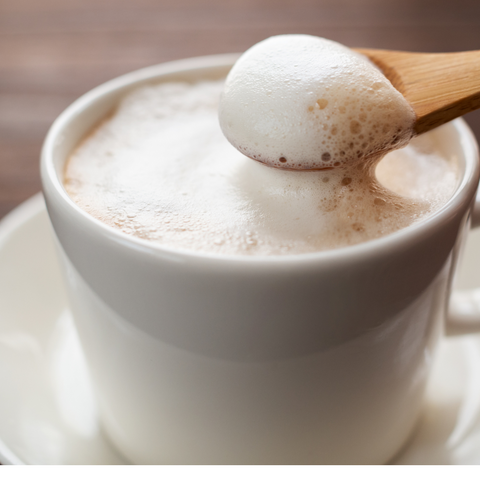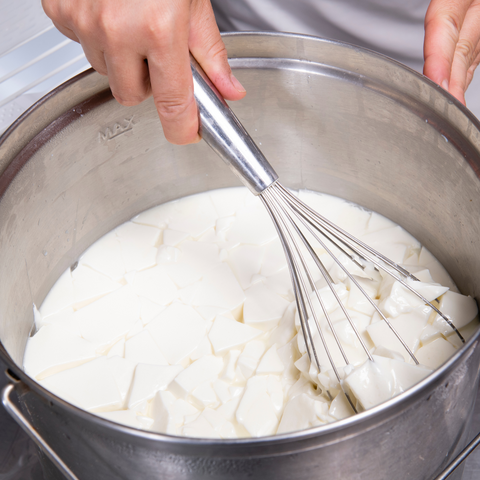While making different types of coffees, you might have heard about frothing milk and steaming milk, but what's the difference?
Almost all espresso-based coffee drinks use either frothed or steamed milk. Those who do not know the difference can get confused. In coffee shops, froth and steamed milk are essential for creamy espresso drinks like cappuccinos and lattes.
This article is a complete guide for those who have difficulty understanding froth vs steamed milk. We will look at both types of milk topping and see how each changes the coffee's texture.
Both processes add air bubbles to the milk. However, results are different in each type. Steamed milk is rich and creamy, while frothed milk is dry like foam and has a mouthful feel.
What is Frothed Milk?

When you see a big layer of foamed milk on the top of the drink, it is froth. Milk is frothed with a whisk or espresso steam wand. It changes the texture of milk. Milk frothing adds bigger air bubbles. This air turns the regular milk into light and airy foam. A steam wand is placed below the surface of the milk to create air bubbles. The aeration process caused the milk to turn into foam.
When frothed with an espresso machine, you need to place the steam wand on the upper layer of the milk. Frothed milk is used in different cappuccino-type recipes.
How to Froth The Milk?

With an Espresso Machine, frothing milk is easy.
- Pour cold milk into a jug, leaving room for the milk to expand.
- Purge the steam wand by turning it on for a few seconds. Purging removes any water content from the wand.
- Place the steam wand a little below the surface of the milk. Don't push it too deep, it will steam milk. The wand remains on the upper surface of the milk. A clear sign is you should hear a splattering sound. Keep steering the milk; once the temperature reaches around 105 degrees Fahrenheit, switch it to texturing milk.
- Angle the jug so that the wand creates a whirlpool effect in the jug, breaking the bubbles and creating smooth foam. Keep lowering the jug as the bubbles rise on the milk surface to ensure the steam wand is below the milk surface, not in bubbles.
- When the thermometer reads 140°F degrees, turn off the steam wand.
- Clean the steam wand and purge it.
What Other Methods of Frothing Milk be used?
Besides the espresso steam wand, a manual frother can be used to froth milk. You can use:
- Handheld frothing wand
- Electric Milk Frothers
- Hand whisks
- Immersion blender
Related article: Aeroccino Vs Steam Wand
What is Steamed Milk?

Many coffee recipes require steamed milk. Some confuse steamed milk with heated milk. Though steamed milk is heated, it is done with steam. Steaming milk is adding steam to milk with a steam wand and the result is an ultra-creamy milk texture. The steaming process breaks the fat in milk and expands to create microbubbles. The milk has a creamier texture. The bubbles created this way are small and covered with milk protein. As a result, milk becomes creamy, thick, and silky. This kind of texture is perfect for latte art.
Steamed milk has a sweet flavor. Steaming also heats the milk, and heat breaks down the lactose( milk sugar) and adds sweetness to the milk.
How to Steam Milk?

- Pour milk into a stainless steel jug or pitcher of milk.
- Purge the steam wand to remove any moisture from the wand.
- Put the steam wand below the surface of the milk.
- Turn on the pitcher and tilt the pitcher so that the steam wand creates a whirlpool effect in the milk.
- Once you have the desired temperature and the pitcher becomes too hot to touch, turn off the steam wand.
- 150-160°F temperature gives sweet milk without overheating it.
How to Steam Milk without Espresso?

There are different ways to steam milk without a steam wand.
- You can steam milk in the microwave after whisking.
- Use a French press and plunge the handle up and down several times.
- Use a Hand whisk or electric milk steamer after heating milk on the stove.
What type of milk is ideal for steaming and Frothing?

Whole milk is ideal for creating the creamy, velvety texture for coffee drinks like rich cappuccino. However, if you need light and airy foam, you can use lighter ones such as 2% or skim milk - but it won't be as velvety or creamy.
Skim or non-fat milk gives a dry foam-like texture, something like bone-dry cappuccino, with a dry layer of foam on the top. It has enough fat content to expand and create a creamy texture of milk. They lack the thick, luscious layer of milk foam and are much lighter.
Dairy may not suit everyone. For those who are lactose intolerant, soy milk, oat milk, and almond milk can be used. Even coconut milk is high in fat and gives a good amount of froth. However, if choosing coconut - make sure you use carton ones, not canned!
Let's look at some key differences between steaming and frothing the milk.
Appearance
- Frothing creates lots of dry foam on the top. It has stiffer bubbles with a lighter body.
- Steaming creates the velvety and creamy texture of milk.
Texture
- Frothers create a dry and light foam texture, perfect for dry cappuccinos. It has a rather neutral taste.
- Steaming creates a smooth texture. The taste is rich as in a perfect latte. Steaming milk has delicate foam on the top, called microfoam.
Types of Milk
- Low-fat milk is ideal for creating dry foam.
- Whole milk is suitable for creating a rich, creamy texture.
Application
- Lattes have steamed creamy milk.
- Dry cappuccino has light foam on the top.
Final Words
Both frothing and steaming milk are different procedures creating different textures. Once you know how to make it you can add it to hot chocolate or other hot or cold drinks.
Choosing one or the other is a matter of personal preference. Almost all popular drinks have either froth or steamed milk on the top. Frothed milk is used for foam-filled beverages. Steaming creates a thick creamy flavor. If you don't have an espresso machine, you can use an electric frother or milk steamer to create foamy milk or a creamy milky texture.
Related Articles
What If I Press Espresso Tamp too Hard
Which Brewing Method Takes the Longest?
LOVE COFFEE? TRY SOMETHING FRESH! PARACHUTE COFFEE FOR $10 LESS!
Use coupon code NEWFRIEND to get $10 off your first shipment! We hand select beans from around the world, roast them weekly, and deliver straight to your door!





